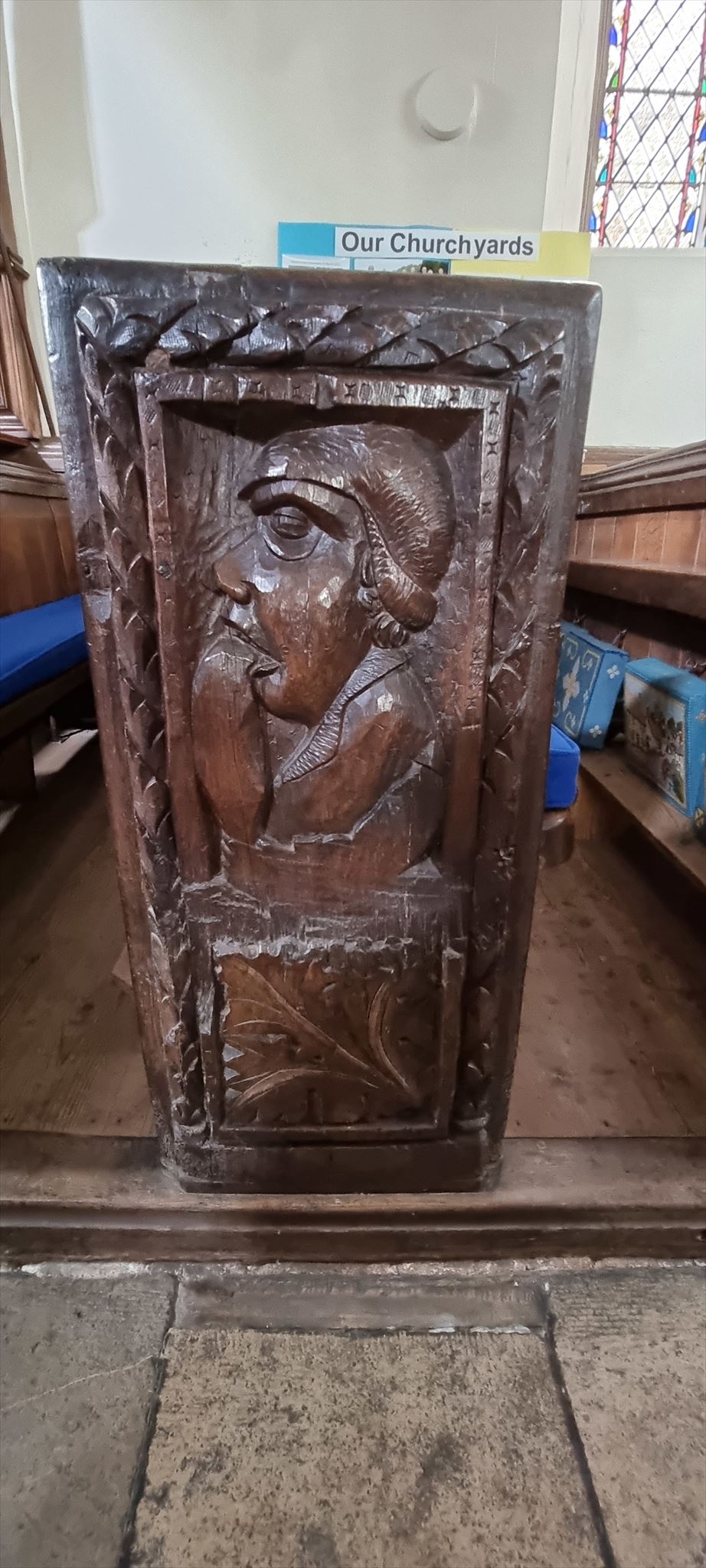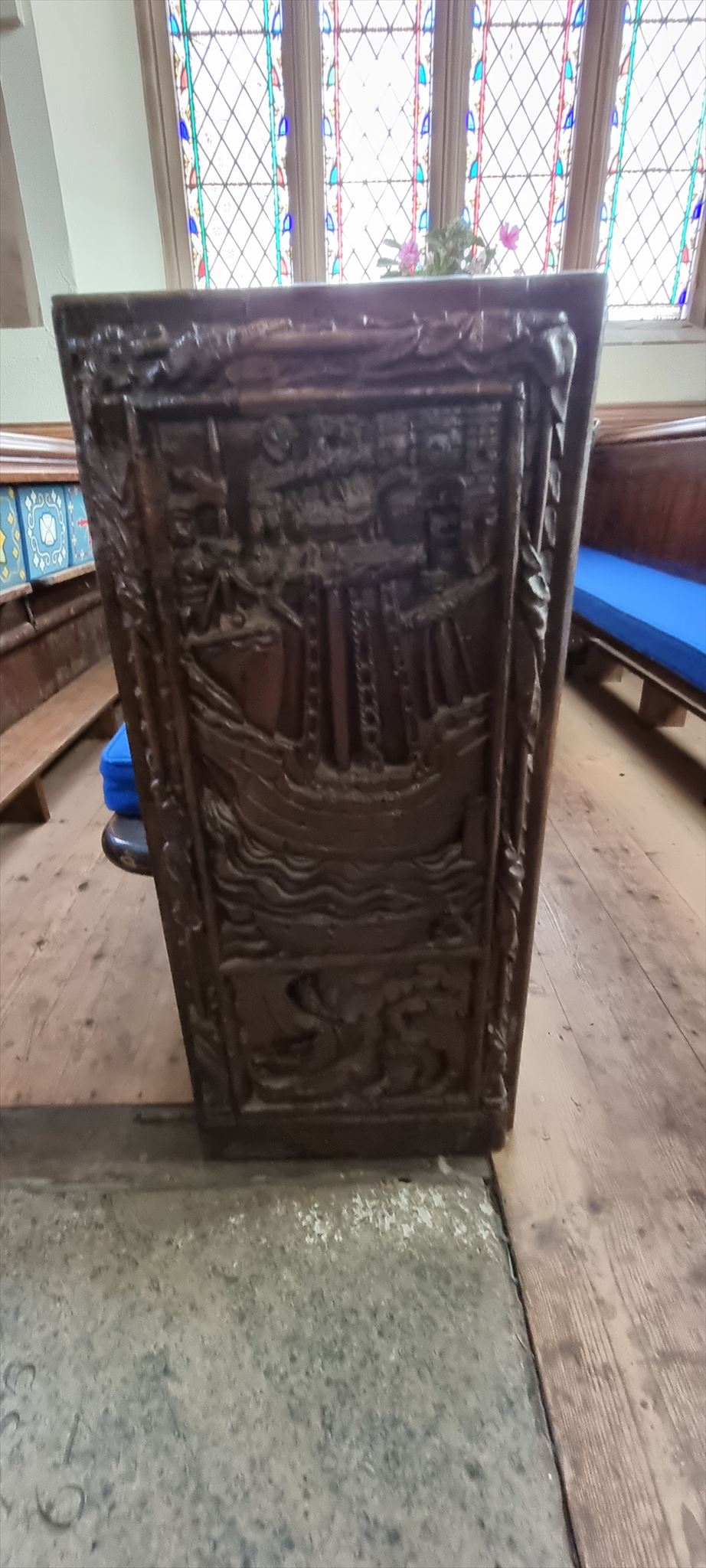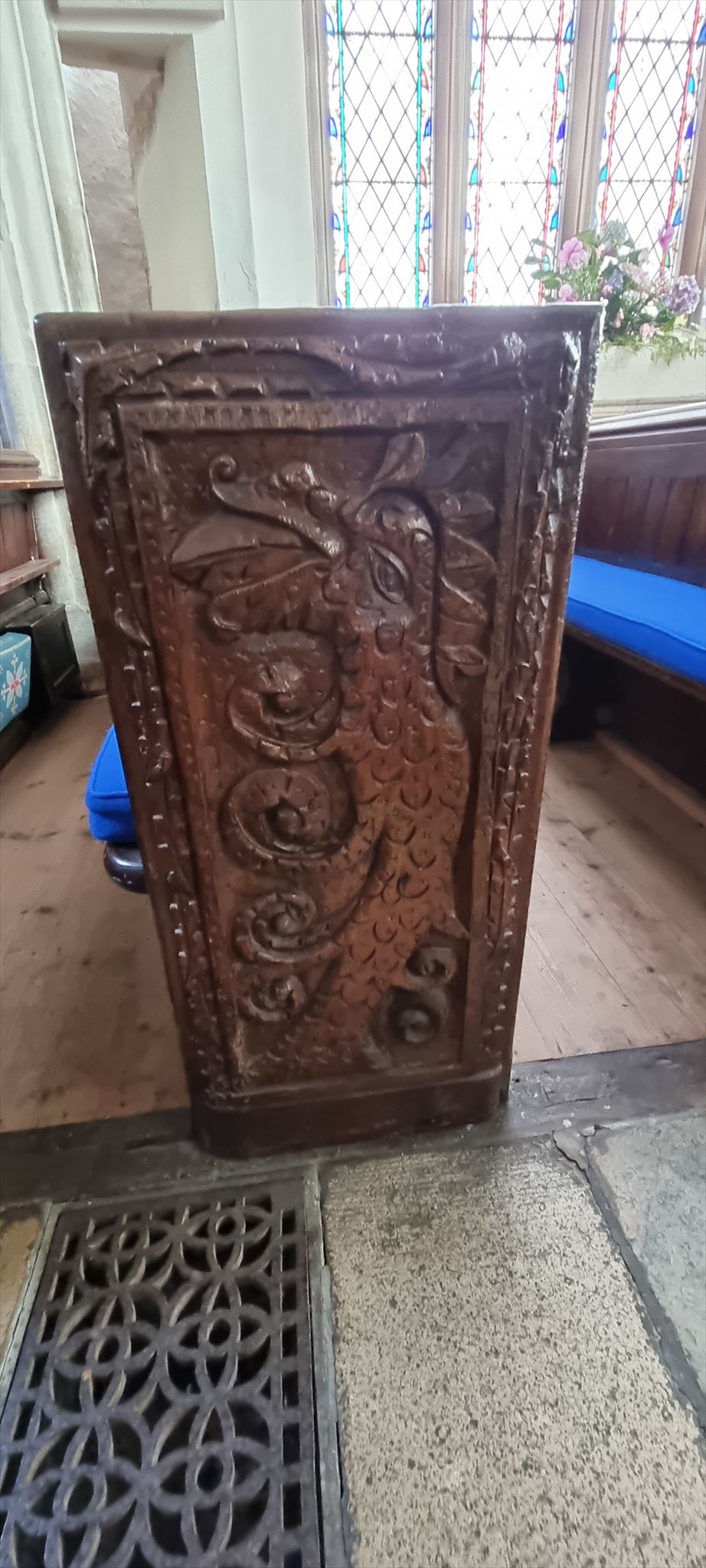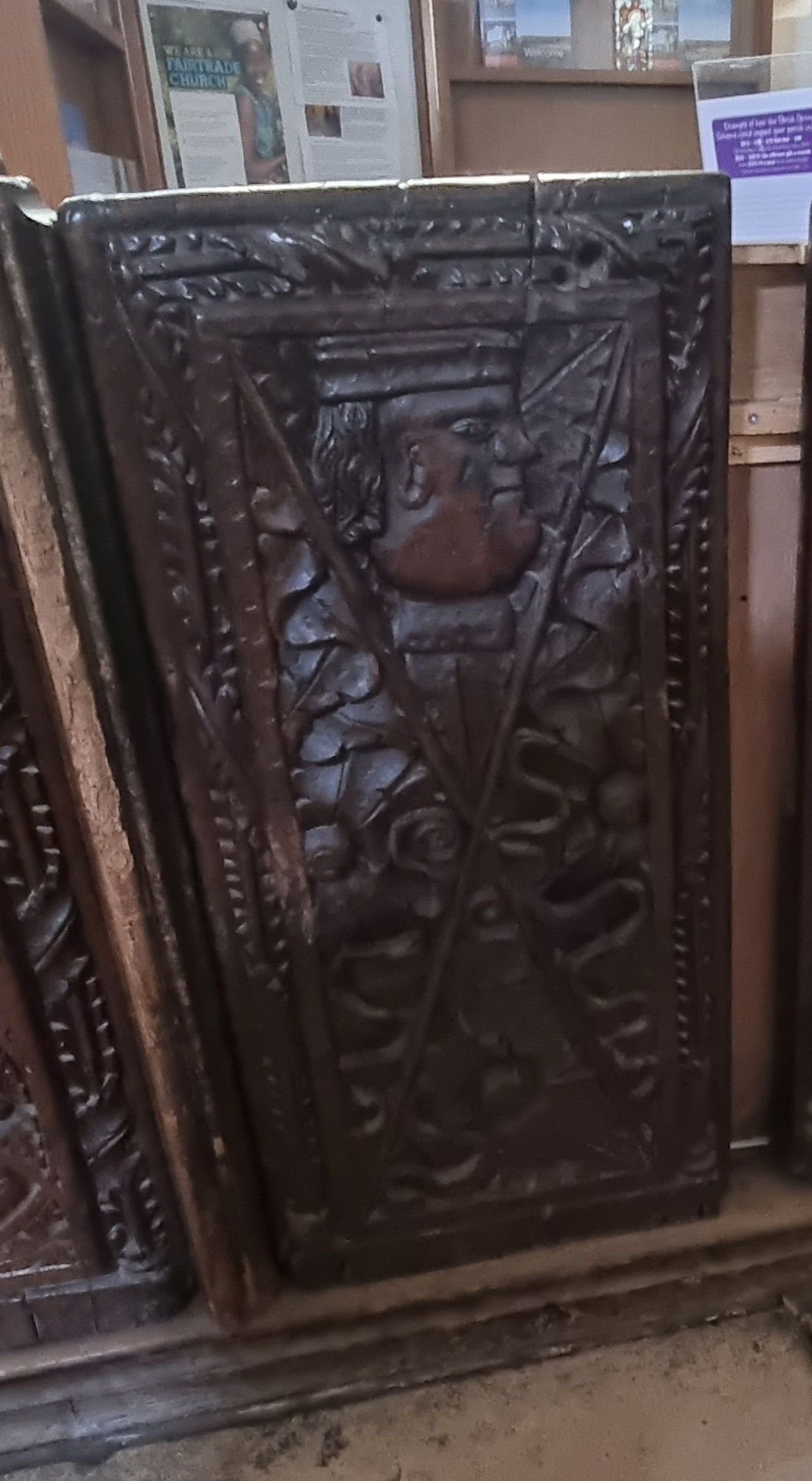All Saints' church, East Budleigh, has about sixty-three sets of bench ends, all carved around 1537 and the most complete set in Devon. They are square-headed and about 3 feet high, and from 16 to 17 inches broad.
On one there is a man’s head with the mouth open, showing the teeth with something between them, whether his tongue or a substance he is supposed to be swallowing it is difficult to say.
"It may have been a carver’s depiction of a tale-bearer punished for his sin by being given an enormous deformed tongue. Or simply a fairground-type freakshow. 
Dr Tisdall, quoted by Hilary Bradt, has a rather different view. “It is my idea that it is a banana. Bananas would have been known to Raleigh’s crew. They sailed via the Azores where bananas were in production and some were taken across to these new West Indies and planted there. So either a banana or a drawing or other memory of a banana would be very likely in East Budleigh.”
There are also some 20th century bench ends of the same calibre, two of them WWI memorials and extremely well executed.
"The sixty carved bench-ends in All Saints Church, East Budleigh are predominantly of the Renaissance, though some have elements of late medieval style. One is dated 1537, a typical date for them all.
The 15th century saw a widespread intellectual reawakening in Europe stimulated and fed by the mass products of the new movable metal type presses. There was a curiosity about the world generated by contemporary voyages of discovery, advances in mathematics, cartography and navigation, a rediscovery of classical art and literature and the questioning of religion. The Copernican revolution in astronomy that profoundly changed perception of man’s home in the universe had also begun. Some of this is apparent in the images on the bench-ends.
From early in the 15th century, as sermons became an important element of worship, fixed seats began to replace stools in churches. It was easier to follow the argument sitting. The All Saints bench-ends adorn what would have been the first fixed seating in the church.
1537 was in the midst of the Reformation following the first step towards underpinning the insecure Tudor dynasty. The Queen had not born the requisite legitimate male heir. Henry VIII was persuaded that re-marriage was the only way forward. In 1527 the pope was petitioned to annul his marriage.
Before he was elected Pope Clement VII (from 1523-34), Cardinal Giulio de Medici had been the principal minister responsible for papal policy. He had also been cardinal protector of England, the monarch’s “ambassador” in papal councils. De Medici had had a long and close relationship with Henry VIII; he promoted papal evaluation of Henry’s refutation of Luther’s critique of the seven sacraments and secured for him the papal accolade “Fidei Defensor”. Henry would have been confident of the success of his petition.
His confidence was misplaced. The pope was constrained from an early favourable decision by Canon Law forbidding the granting of a second annulment to Catherine. Moreover the pope, who had already been imprisoned during the Hapsburg occupation of Rome in 1527, was threatened with a renewed military attack on Rome by the naval forces of the Emperor Charles V to deter any papal agreement to annul his Aunt Catherine’s marriage.
By 1532 Henry’s patience was exhausted. He married Anne Boleyn triggering excommunication in 1533. Catholic rulers were now obliged to depose Henry and there was a risk of the preaching of a crusade against England. The Act of Supremacy, establishing the Church of England with the King as head was passed the following year.
Monasteries were dissolved in 1539 and All Saints Church was confiscated from Polsloe Priory. Warm feelings boiled over in 1549 when Rebellions against the new prayer book broke out. Exeter was besieged by rebels for two days. Two thousand died in the suppression of the rebellion after battles at Clyst St Mary and Woodbury Common.
However none of these feelings, nor any aspect of religion appears in the imagery of the bench-ends. It embraces modernism, the Renaissance fascination for classical culture and iconic threats of the Dark Ages. A celebration of land and mercantile wealth is juxtaposed with a discovery of Ovid's concept of Metamorphosis with transgressing humans punished by transformation into plants by offended gods and with the Romayne heads and bestiaries from Roman villas of classical culture.
The well-to-do rented the best seats to appraise the sermon, at the chancel end of the nave, where the images on eleven bench-ends reflect land or mercantile wealth.
The dated bench-end is on one of the two pews of the Raleigh family. 
Walter Ralegh senior, a young Exmouth ship-owner who settled in East Budleigh when he married Joan Drake of Littleham in 1518, was one of the most prominent Protestant reformers in Devon. As churchwarden, he was responsible to the bishop for implementation, in East Budleigh, of the provisions of the new Church of England. In 1549, the year of the Western Rebellion he was kidnapped by Clyst St Mary rebels before rescue by Exmouth mariners. The defacing of his shield on the bench-end may reflect some unpopularity at this time. Ralegh continued trading from Exmouth until at least 1552.
Another mercantile-related bench-end shows an armed merchant ship. (visit link) 
East Budleigh had been a busy medieval port with international trade and ships serving the crown. However centuries of longshore drift of shingle across the mouth of the River Otter with progressive accumulation of silt upstream constricted shipping and finally closed the port to all but coastal traffic and fishing around 1470. Shipping operations were moved to Exe ports, though ship-owners continued to live in East Budleigh during the 16th century.
Pictorial evidence suggests the ship had been a foreign prize captured in some past naval battle and bought by an East Budleigh man in the last decade of the 15th century to be re-fitted for a trading venture to North Africa. It was too large for the Otter estuary. The owner used one of the Exe ports.
Another carving on a cloth merchant’s pew contains elements of the arms of the Company of Weavers and Fullers of Exeter.
Some fifty other seats for reserved for the general public rather than a particular family. They are scattered throughout the nave. About thirty have foliate designs. with the free-flowing sinuous vegetative shapes characteristic of renaissance styles. Several feature metamorphosis into or from animate shapes such as dolphins or a crocodile, and fabulous creatures inspired by bestiaries on newly found Roman villas that were influencing renaissance fashion. These include a dragon, and a fishy monster,
and a woman in a conch is emerging from sin  ."
."
SOURCE - (Visit Link)
pictograms of mariners decorate seats for the unmarried men 